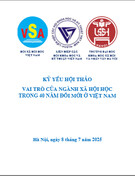
http://www.iaeme.com/IJMET/index.asp 1535 editor@iaeme.com
International Journal of Mechanical Engineering and Technology (IJMET)
Volume 10, Issue 03, March 2019, pp. 1535–1542, Article ID: IJMET_10_03_154
Available online at http://www.iaeme.com/ijmet/issues.asp?JType=IJMET&VType=10&IType=3
ISSN Print: 0976-6340 and ISSN Online: 0976-6359
© IAEME Publication Scopus Indexed
THE EFFECT OF JOB DESIGN AND QUALITY
OF WORK LIFE TOWARD AFFECTIVE
COMMITMENT OF TEACHERS
Lukman Tamhir*
Universitas Negeri Jakarta
Jln. Rawamangun Muka Jakarta Timur -13220 Indonesia
Bedjo Sujanto
Universitas Negeri Jakarta
Jln. Rawamangun Muka Jakarta Timur -13220 Indonesia
Netti Karnati
Universitas Negeri Jakarta
Jln. Rawamangun Muka Jakarta Timur -13220 Indonesia
*Corresponding Author
ABSTRACT
The purpose of this study was to analyze the direct influence of job design and
quality of work life on the affective commitment of teachers. This research method with
a quantitative approach and data analysis techniques using path analysis. The findings
of this study prove the direct effect of job design on affective, there is a positive direct
effect quality of work life on affective commitment and there is a positive direct effect of
job design on the quality of work life. The conclusion is that increasing the teacher's
affective commitment must be supported by the job design and the quality of work life
properly, effectively and efficiently..
Key words: Job design; Quality of work life; Affective commitment
Cite this Article: Lukman Tamhir, Bedjo Sujanto, Netti Karnati, The Effect of Job
Design and Quality of Work Life Toward Affective Commitment of Teachers,
International Journal of Mechanical Engineering and Technology 10(3), 2019, pp.
1535–1542.
http://www.iaeme.com/IJMET/issues.asp?JType=IJMET&VType=10&IType=3
1. INTRODUCTION
Commitment to each individual is very important because with a commitment one can be more
responsible for his work compared to individuals who have no commitment. Usually
individuals who have a commitment, will work optimally so that they can devote their attention,
mind, energy and time to their work, so that what they have done is in accordance with what is

The Effect of Job Design and Quality of Work Life Toward Affective Commitment of Teachers
http://www.iaeme.com/IJMET/index.asp 1536 editor@iaeme.com
expected by the organization. Organizational commitment is a form of attitude. Attitudes can
be grouped into three basic components, namely: emotional, informational and behavioral [1].
In organizational behavior, organizational commitment is a component of behavior. "In
organization, attitudes are important because of their behavioral component" [2]. Attitude is a
statement about someone's assessment of objects, people or events.
In organizational behavior, there are various concepts about organizational commitment.
[3] that organizational commitment is the level of identification of individuals with
organizations and is committed to achieving organizational goals. Furthermore [4] that
organizational commitment is the level at which individuals side with a particular organization
and its objectives and desire to maintain membership in the organization. Specifically [5]
defines organizational commitment as (1) a strong desire to remain a member of an
organization; (2) willingness to mobilize a high level of effort for the organization; (3) a certain
belief and acceptance of the values and objectives of the organization. In other words, this is an
attitude that reflects employee loyalty to the organization and is an ongoing process whereby
members of the organization express their concern for the organization and continued success
and welfare that affective commitment is the emotional bond of employees to the organization,
identification with the organization, and involvement in the organization. Members of
organizations with high affective commitment will continue to be members of the organization
because they want it (want to).
Affective commitment is that employees are happy to be members of the organization,
believe in and feel good about the organization and what it stands for, are attached to the
organization, and intend to do what is good for the organization [6] Affective commitment is a
psychological attachment of individuals characterized by individual acceptance of
organizational goals, involvement and a strong desire to survive in the organization. Dessler
cited in [5] suggests the following specific guidelines for implementing management systems
that must help solve current dilemmas and increase employee organizational commitment: first,
commit to values that prioritize people; second, clarify and communicate your mission; third,
guaranteeing organizational justice; fourth, create a sense of togetherness and fifth, support
employee development.
Teachers with strong affective commitment make their membership in an organization
because they want to do it or in other words, members like. Meyer and Allen's organization,
quoted in, [5] furthermore, it is emphasized that there are three causes or factors that give rise
to members' affective commitment to the organization, namely individual characteristics,
organizational structure, and work experience. These three factors need to be sought by the
school principal in order to grow the teacher's affective commitment to the school. [7] argues
that leadership is a process to influence others to understand and agree with what needs to be
done and how the task is carried out effectively, as well as a process to facilitate individual and
collective efforts to achieve common goals. inspire, motivate, and direct their activities to help
achieve group or organizational goals.
Teacher professionalism is an indicator of the teacher's commitment to the profession as
well as the school as the organization where he teaches. Teachers should be an agent of change
to successfully face the challenges in the industrial revolution [8]. According to [9] Educational
resources is realized through the construction of the peer community, which lays the foundation
for the overall management of the educational resources, to meet the needs of educational
resource management. To reach professional and high-quality teachers, it is necessary to take
part in various teacher training and education programs. Based on research findings [10]
explained that the teacher had a very good perception of the program, where this training is
considered to help them improve their knowledge and skills prepare lesson plans and do the
teaching.

Lukman Tamhir, Bedjo Sujanto, Netti Karnati
http://www.iaeme.com/IJMET/index.asp 1537 editor@iaeme.com
A teacher who has an affective commitment will try to work seriously as an appreciation of
the profession that is owned, in addition to realizing the goals to be achieved by the school
wholeheartedly for the advancement of educational institutions. each employee has a different
basis and behavior based on his or her commitment to the organization. Teachers with affective
commitment really want to be a professional, creative and innovative teacher concerned so that
they have the desire to use optimal business to achieve organizational goals. Job design is the
allocation of types of work by considering several ideas and then combining the work with the
tasks of the employee, and the task is adjusted to the organizational goals and needs of the
individual. Job design, the delineation of task responsibilities as regulated by organizational
strategy, technology, and structure, is a key determinant of individual motivation and ultimately
of organizational success [3]. Job design trying to improve efficiency and effectiveness of work,
matching individual tasks with groups, and achieving quality work life and job satisfaction for
each individual to do work. [11] Explain that job design the process of assigning tasks to a job,
including the interdependence of tasks with other jobs. Job designs dimensions can interact
effectively to enhance positive behavior and sustain greater commitment [12]. Luthan &
Jonathan (2012:440) Job design of a job's content, the methods that are used on the job, and the
way in which the job relates to other jobs in the organization [1].
Job design needs to have a piece of knowledge, skills, motivation, and good job design
techniques and create a conducive working climate and influence affective commitment to
achieve organizational goals. Research results of [13] “Various aspects of job design influence
employees' affective commitment". Work must be designed as well as possible so that it can
provide a benefit and can increase commitment to both the organization and employees.
Benefits to the organization in the form of achieving organizational goals effectively and
efficiently. Job design is absolutely owned by every organization because in the design of the
work carried out by the principal by arranging a number of tasks into a job so that the work
done becomes clearer and more directed based on the knowledge and skills of the teacher.
The quality of work life is one form of philosophy applied by management in managing
organizations in general and human resources in particular. According to [14] That the quality
of work life as philosophy, is a way of management's view of humans, workers, and
organizations. The main elements in the philosophy are management's concern about the impact
of work on humans, the effectiveness of the organization and the importance of employees in
solving decisions especially those concerning work, career, income and their destiny in work
[15]. QWL programs are another way in which organizations recognize their responsibility to
develop jobs and working conditions that are excellent for people as well as for the economic
health of the organization [16]. To achieve a good quality of work life, it requires high affective
commitment. The results of the study prove that the quality of work life is very influential on
affective commitment. This is consistent with the findings of [17] there is a positive and
meaningful relationship between the quality of work life and its dimensions including a safe
and healthy environment, development of human capabilities, constitutionalism, social
integration and the total life space with the organizational commitment. The teachers' quality
of work life has significantly negative effects on school alienation and burnout levels and a
significantly positive effect on affective commitment [18].
Furthermore, [19] that QWL has a very significant role in the variables since it determines
how the organization is perceived". Whereas to improve the quality of work life also consider
the design of good and effective work. The first step towards the improvement of QWL is to
consider the topic of job design and organization.
2. METHOD

The Effect of Job Design and Quality of Work Life Toward Affective Commitment of Teachers
http://www.iaeme.com/IJMET/index.asp 1538 editor@iaeme.com
The research was carried out in Junior High School Ternate, North Maluku Province. This study
uses a survey method with a quantitative approach [19]. Data analysis techniques with path
analysis [20], [21]. Collecting data with a questionnaire. This study examines the
interrelationship between research variables and analyzes the influence of job design variables,
work life quality, and affective commitment. The research hypothesis is shown in Figure 1.
Figure 1. Research Hypothetic Model
3. RESULT AND DISCUSSION
3.1. Descriptive Statistics
Data on job design variables, work life quality, and affective commitment are presented in the
form of descriptive statistics. Descriptive statistics are used to explain the size of the
concentration of data and disseminate data, namely range, minimum, maximum, mean, standard
deviation, and variance. Summary of statistical descriptive data in table 1.
Table 1 Summary of Descriptive Statistics
N
Range
Minimu
m
Maxim
um
Mea
n
Std.
Deviation
Variance
Job Design
92
48
98
146
120.
09
12.654
160.124
Quality of work
life
92
48
98
146
121.
65
12.343
152.361
Affective
Commitment
92
48
97
145
120.
75
13.127
172.321
Valid N
92
3.2. Test Normality
Calculation obtained by Lhitung value of 0.063 <Ltable value of 0.092 (n = 92; α = 0.05).
Because the Lcount value is <Ltable, the data on the affective commitment to job design tend
to be normally distributed. The value of Lcount was 0.061 <Label value of 0.092 (n = 92; α =
0.05). Because the Lcount value is <Ltable, then the affective commitment data on the quality
of work life tends to be normally distributed. The value of Lcount was 0.047 <Ltabel value of
0.092 (n = 92; α = 0.05). Because the value of Lcount <Ltabel then the distribution of data The
quality of work life on job design tends to form curves with the normal distribution (see table.2).
Table 2 Summary of Normality Test
N
Lcount
Ltable
Information

Lukman Tamhir, Bedjo Sujanto, Netti Karnati
http://www.iaeme.com/IJMET/index.asp 1539 editor@iaeme.com
3.3. Test
of Significance and Linearity of Regression
Regression Equations Y= 49.59 + 0.59 X1 for significance tests obtained F count = 43.59>
Ftable = 6.93 at α = 0.01. Because Fcount> Ftable, the regression equation is stated to be very
significant. For linearity test obtained Fcount of 1.56 <Ftable = 1.64 at α = 0.05. Because Fcount
<Ftable, the distribution of estimated points forming linear lines is acceptable. Regression
equation Y = 41.65 + 0.65 X2, for the significance test obtained F count = 53.72> Ftable = 6.93
at α = 0.01. Because Fcount> Ftable, the regression equation is stated to be very significant. For
linearity test obtained Fcount of 0.57 <Ftable = 1.66 at α = 0.05. Because Fcount <Ftable, the
distribution of estimated points forming linear lines is acceptable. Regression equation X2 = -
48.65 + 0.61 X1, for the significance test obtained Fcount = 57.15> Ftable = 6.93 at α = 0.01.
Because Fcount> Ftable, the regression equation is stated to be very significant. For linearity
test obtained Fcount of 1.10 <Ftable = 1.64 at α = 0.05. Because Fcount <Ftable, the distribution
of estimated points forming linear lines is acceptable. Summary of data in table 3.
Table 3 Summary of Significance Test Results and Regression Linearity Test
Regression
Regression
Equations
Signification Test
Linearity Test
Fcoaut
Ftable = α =
0,01
Fcount
Ftable = α = 0,05
Y over X1
Y = 49,59 +
0,59X1
43.59**
6.93
1.56ns
1.64
Y over X2
Y =-49,65
+0,65X2
53.72**
6.93
0.57ns
1.66
X2 over X1
X2 =-48,65 +
0,61X1
57.15**
6.93
1.10ns
1.64
3.4. Test Path Coefficient Analysis
The path analysis coefficient then there is a correlation between job design (X1) with affective
commitment (Y) of 0.571. Quality of work life (X2) with affective commitment (Y) of 0.611.
The correlation between job design (X1) with work life quality (X2) is 0.623. Summary of data
in table 4.
Table 4 Summary of Test Significance of the Path Coefficient
Correlation
coefficient
Path Coefficient
Tcount
ttable
Conclusion
0.05
0.01
ry1
=
0.571
py1
=
0.311
3,05**
1.99
2.63
Very significant
ry2
=
0.611
py2
=
0.418
4,09**
1.99
2.63
Very significant
r21
=
0.623
p21
=
0.623
7,56**
1.99
2.63
Very significant
3.5. Test the Hypothesis
After conducting path analysis, the results are used as a basis for answering hypotheses
and drawing conclusions in this study. Hypothesis summary table 5.
Regression Estimation
Error
α = 0,05
Y over X 1
92
0,063
0,092
Normal
Y over X 2
92
0,061
0,092
Normal
X 2 over X 1
92
0,047
0,092
Normal















![Tài liệu tập huấn quản trị công tác xã hội, chính sách và hoạch định [chuẩn nhất]](https://cdn.tailieu.vn/images/document/thumbnail/2025/20251205/namthangtinhlang_04/135x160/6561764990558.jpg)
![Làm việc nhóm và cộng đồng: Tài liệu tập huấn [Chuẩn nhất]](https://cdn.tailieu.vn/images/document/thumbnail/2025/20251205/namthangtinhlang_04/135x160/74161764990559.jpg)




![Hướng dẫn nhận diện, đánh giá khó khăn tâm lý của học sinh trong trường học: Tài liệu [chuẩn nhất]](https://cdn.tailieu.vn/images/document/thumbnail/2025/20251205/namthangtinhlang_04/135x160/86381764992572.jpg)

![Giáo trình công tác xã hội với trẻ tự kỷ [mới nhất]](https://cdn.tailieu.vn/images/document/thumbnail/2025/20251205/namthangtinhlang_04/135x160/19871764994621.jpg)


